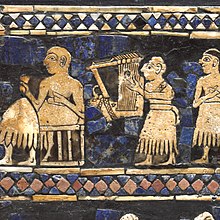Standard of Ur: Difference between revisions
Ghirlandajo (talk | contribs) too many images for a stub |
to reduce ambiguity I changed the link on "standard" in the second paragraph to link to "standard bearer |
||
| Line 3: | Line 3: | ||
The '''Standard of Ur''' (also known as the "Battle Standard of Ur," or the "Royal Standard of Ur") is a [[Sumer]]ian [[Artifact (archaeology)|artifact]] excavated from what had been the Royal Cemetery in the ancient city of [[Ur]] (located in modern-day [[Iraq]] south of [[Baghdad]]). The Standard of Ur dates from around [[26th_century_BC|2600 BC]], and was excavated by British [[archaeologist]] [[Leonard Woolley]] in the [[1920s]]. |
The '''Standard of Ur''' (also known as the "Battle Standard of Ur," or the "Royal Standard of Ur") is a [[Sumer]]ian [[Artifact (archaeology)|artifact]] excavated from what had been the Royal Cemetery in the ancient city of [[Ur]] (located in modern-day [[Iraq]] south of [[Baghdad]]). The Standard of Ur dates from around [[26th_century_BC|2600 BC]], and was excavated by British [[archaeologist]] [[Leonard Woolley]] in the [[1920s]]. |
||
It is essentially a hollow wooden box measuring 8.5 inches high and 19.5 inch long, inlaid with a [[mosaic]] of shell, red [[limestone]] and [[lapis lazuli]]. It is currently in a reconstructed state, as the effects of time over the last several millennia had decayed the wooden frame and [[bitumen]] glue which had cemented the mosaic in place. Its original function is not conclusively understood. Leonard Wooley suggested that it had been carried on a pole, borne as a [[ |
It is essentially a hollow wooden box measuring 8.5 inches high and 19.5 inch long, inlaid with a [[mosaic]] of shell, red [[limestone]] and [[lapis lazuli]]. It is currently in a reconstructed state, as the effects of time over the last several millennia had decayed the wooden frame and [[bitumen]] glue which had cemented the mosaic in place. Its original function is not conclusively understood. Leonard Wooley suggested that it had been carried on a pole, borne as a [[standard bearer|standard]]. It has also been speculated that it was the soundbox of a musical instrument. |
||
[[Image:Sumerian_lyre.jpg|left|thumb|Lyre similar to that depicted in "Peace."]]The Standard of Ur has two main panels, which have been named "[[War]]" and "[[Peace]]." "War" is one of the earliest representations of a Sumerian army, engaged in what is believed to be a border skirmish and its aftermath. Battle scenes include four-wheeled chariots, drawn by teams of some sort of [[equine]] (possibly [[onagers]]) trampling enemies (although these solid-wheeled early chariots must have been rather unwieldy in battle, and it is likely that they were used primarily for transport and defense); spearmen clad in armored cloaks; and other [[infantry|infantrymen]] bearing sickle-like knives or axes. Panels also depict prisoners, wounded, naked, and humiliated, being presented to the king |
[[Image:Sumerian_lyre.jpg|left|thumb|Lyre similar to that depicted in "Peace."]]The Standard of Ur has two main panels, which have been named "[[War]]" and "[[Peace]]." "War" is one of the earliest representations of a Sumerian army, engaged in what is believed to be a border skirmish and its aftermath. Battle scenes include four-wheeled chariots, drawn by teams of some sort of [[equine]] (possibly [[onagers]]) trampling enemies (although these solid-wheeled early chariots must have been rather unwieldy in battle, and it is likely that they were used primarily for transport and defense); spearmen clad in armored cloaks; and other [[infantry|infantrymen]] bearing sickle-like knives or axes. Panels also depict prisoners, wounded, naked, and humiliated, being presented to the king |
||
Revision as of 08:35, 24 December 2006

The Standard of Ur (also known as the "Battle Standard of Ur," or the "Royal Standard of Ur") is a Sumerian artifact excavated from what had been the Royal Cemetery in the ancient city of Ur (located in modern-day Iraq south of Baghdad). The Standard of Ur dates from around 2600 BC, and was excavated by British archaeologist Leonard Woolley in the 1920s.
It is essentially a hollow wooden box measuring 8.5 inches high and 19.5 inch long, inlaid with a mosaic of shell, red limestone and lapis lazuli. It is currently in a reconstructed state, as the effects of time over the last several millennia had decayed the wooden frame and bitumen glue which had cemented the mosaic in place. Its original function is not conclusively understood. Leonard Wooley suggested that it had been carried on a pole, borne as a standard. It has also been speculated that it was the soundbox of a musical instrument.
The Standard of Ur has two main panels, which have been named "War" and "Peace." "War" is one of the earliest representations of a Sumerian army, engaged in what is believed to be a border skirmish and its aftermath. Battle scenes include four-wheeled chariots, drawn by teams of some sort of equine (possibly onagers) trampling enemies (although these solid-wheeled early chariots must have been rather unwieldy in battle, and it is likely that they were used primarily for transport and defense); spearmen clad in armored cloaks; and other infantrymen bearing sickle-like knives or axes. Panels also depict prisoners, wounded, naked, and humiliated, being presented to the king

"Peace" portrays a banquet scene. Attendants parade animals, fish, and other goods (possibly war booty) before seated figures, while a lyrist entertains the throng.
The Standard of Ur is currently housed in London's British Museum.
